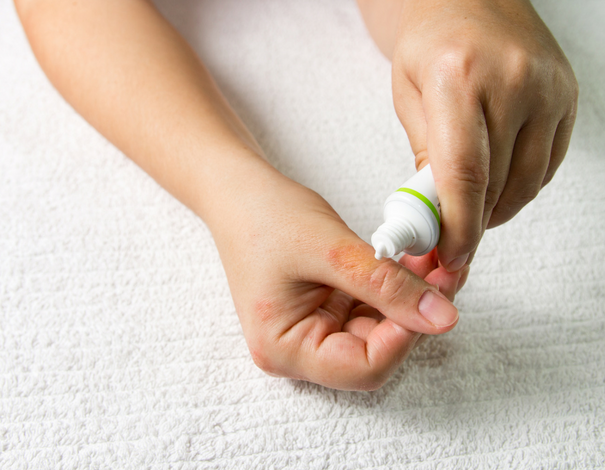Most Common Skin Rash Causes, Types, and Treatments
Some areas of your skin have become red and you’re not sure what’s the cause? Read on to discover the most common causes of rashes.
Skin rashes are characterized by the appearance of spots or redness on the skin. They can cover a large part of the body or be restricted to one small area. They may appear on their own or be accompanied by other symptoms such as itching or pain. The cause of a skin rash may be obvious or, on the contrary, may require some detective work.
Here are some of the most common causes of skin rashes:
- Cellulitis
- Hives
- Eczema
- Psoriasis
- Contact dermatitis
- Insect or animal bites
- Reaction to medication
- Exposure to elements
- Viral, bacterial and fungal infections
Hives (urticaria)
The term "hives" is sometimes used to describe any type of rash. However, hives are a specific type of rash, and not all rashes are hives!
Hives are red, itchy, slightly raised bumps on the skin that are often accompanied by intense itching. They have defined edges and may have a pale centre. Generally, hives come and go in groups and may disappear and reappear elsewhere on the body before they go away completely.
Hives may be caused by an allergic reaction (e.g., to foods, pets, insects or medication), an autoimmune disease or a physical stimulus (e.g., hot or cold temperature, sunlight, friction), but in many cases, the exact cause remains unknown.
Hives are treated with an oral antihistamine. Oral corticosteroids may be used in severe cases, but topical corticosteroid creams are not useful to treat hives.
Eczema
Eczema, also called atopic dermatitis, is a very common skin problem in young children that can persist through to adulthood. It usually appears as a red rash, typically around the elbows or knees, or on the cheeks, neck, wrists, or ankles, and tends to occur in cycles. The rash is accompanied by an intense itching sensation. Scratching the skin can break it, which can lead to complications. Mittens can be a helpful tool for young children or people with cognitive impairments when it's difficult to prevent them from scratching.
The key to treating eczema is moisturizing the skin every day, including during symptom-free periods. When the skin is well hydrated, it's less likely to react to triggers such as prickly fabrics, allergens or stress. If you're dealing with an eczema flare, a health professional may prescribe a corticosteroid cream or other treatments to help relieve the symptoms.

Psoriasis
Plaque psoriasis, which is the most common form of psoriasis, is characterized by distinctive red patches that are covered with grayish scales. These patches can appear anywhere on the body, but are most often found on the elbows, knees, scalp, chest, or lower back.
The disease has a cyclical nature, with periods of exacerbation and remission. It is a chronic condition, and while symptoms can be managed, there is currently no cure.
Treatment typically involves maintaining proper skin hydration, in association with various medications depending on the severity of the psoriasis.
Contact Dermatitis
Contact dermatitis occurs when the skin comes in contact with an irritating substance, for example, household cleaners or poison ivy, or to something the person is allergic to, like nickel.
Another example of contact dermatitis is diaper rash, which is caused by contact with urine or feces.
One thing that sets contact dermatitis apart is that the rash is limited to the area that came into contact with the substance causing it. It may be accompanied by itching, pain or blisters.
It's important to figure out what's causing the rash so you can stop it from happening again. Sometimes it's obvious, but other times it takes a bit of detective work to find the source. If you can identify and avoid the substance causing the reaction, the rash usually clears up in a few weeks. A corticosteroid cream can be applied on the rash to reduce the redness and itchiness.
The most important step is identifying and avoiding the substance causing the reaction (e.g., soaps, plants, metals). The rash typically clears within a few weeks once exposure stops. A mild-to-moderate corticosteroid cream can be applied to reduce redness, swelling, and itching. In more severe cases, an oral antihistamine may be recommended to control itching. Keep the affected area clean and avoid scratching to prevent infection.
Insect or Animal Bites
Insect bites (e.g., mosquitoes, fleas, bedbugs) generally cause localized redness or swelling around the site of the bite. They can also cause pain or itchiness of varying intensity.
The number of bites and their location on the body can be an indicator to help identify the insect. Treatment is generally not necessary unless the bites are very numerous or cause significant discomfort. In such cases, cool compresses, or an over-the-counter anti-itching cream can be applied. Your pharmacist can recommend an appropriate product.
If you have been bitten by a tick, you should consult a healthcare professional as soon as possible if you are in an area at risk of Lyme disease. They will be able to assess the situation and prescribe a preventive treatment when required.
Travel-related diseases can also be spread by insect and animal bites. To reduce risks, be sure to have the appropriate vaccinations for your destination and take all recommended protective measures. Don't wait until the last minute to seek travel health advice and vaccination information, as some preventive treatments and vaccines need to be started several weeks before you arrive at your destination.
Some insect bites, including wasp or bee stings, can cause a serious allergic reaction that requires emergency treatment. In this case, the skin rash tends to spread rapidly over a large part of the body and is accompanied by other symptoms such as shortness of breath or heart symptoms. Individuals with allergies to these insects must carry an epinephrine auto-injector with them at all times when they go outside (during the months when these insects are active).
Various animals and parasites that live in water can also cause skin reactions, for example, contact with jellyfish or the parasite that causes “swimmer’s itch.”
Most bites improve on their own. To relieve symptoms, apply a cool compress to reduce swelling and use an over-the-counter anti-itch cream or oral antihistamine to manage itchiness and discomfort. Avoid scratching, as this can lead to infection. In cases of severe allergic reactions (e.g., difficulty breathing, widespread rash), seek emergency care immediately. People with known insect sting allergies should carry an epinephrine auto-injector at all times.
Reaction to Medication
A number of medications, including antibiotics and aspirin, can cause a skin rash. With antibiotics, since some infections can also cause a skin rash, it can be difficult to tell whether the rash is a reaction to the medication or a symptom of the illness.
Most skin rashes caused by medication are minor. However, sometimes the reaction may be caused by an allergy to the medication and require medical care. If you experience a skin rash after taking a medication, seek your pharmacist’s professional advice. If your symptoms are severe, do not hesitate to call 911.
Some medications can make skin highly sensitive to the sun, resulting in spots and blisters, even with very brief exposure to the sun. Your pharmacist will inform you if one of your medications is associated with this effect. It is important to always protect your skin from the sun while taking such medication.

Exposure to the Elements
In very hot and humid weather, heat rash, also known as prickly heat, can appear when the sweat glands become blocked. The rash usually disappears when the skin's temperature cools, for example, after applying cold compresses.
Exposure to very cold temperatures can result in frostbite of the extremities (fingers, toes, nose, ears). The initial stage of frostbite (frostnip) is often redness of the skin, accompanied by a sensation of tingling or pain. In such instances, the affected area should be gently warmed for instance by wrapping it in a blanket. If the skin is white, waxy-looking, and cold to the touch, the frostbite is severe and requires immediate medical attention.

Viral, Bacterial and Fungal Infections
Several viral and fungal infections can be accompanied by a skin rash, for example hand-foot-and-mouth disease (viral) and athlete’s foot (fungal). In addition to the above-described cellulitis, other skin infections can be caused by bacteria, such as impetigo. The specific location of the rash on the body, its appearance, the speed at which it appeared, and the presence of other symptoms can all help to identify the probable cause of infection. Rashes resulting from bacterial or fungal infection typically require treatment with antibiotics or antifungals. In the event that the rash is associated with a viral infection, it will usually dissipate as the infection heals, often without the need for further treatment. Shingles is a viral infection that requires treatment, as it can lead to long-term sequelae in some cases. It can be recognized by the clustering and typical appearance of blisters on the body. It is treated with antiviral medications. It is possible to prevent certain viral infections that cause rashes through vaccination. These include chickenpox and measles vaccines in children, and shingles vaccines in older adults.
Moisturizer, an Essential Ally for Healthier Skin
Skin that is well hydrated is more resilient and better able to withstand the many aggressions it is faced with on a daily basis.
In the case of chronic skin conditions such as eczema and psoriasis, the use of moisturizers is of particular importance, given that the skin’s barrier function is often compromised. It is recommended that a moisturizer be applied daily to the affected areas, unless otherwise directed by a healthcare professional.
It is important to choose a moisturizer carefully, as some ingredients, such as perfumes and dyes, may aggravate symptoms. Lotions are convenient for large areas, but they may not provide as much moisturizing power as a cream. For very dry areas, an ointment could be a good option, despite its stickier texture.
Your Pharmacist Is Here for You!
Don't hesitate to seek professional advice from your pharmacist if you develop a rash. In many provinces, pharmacists can prescribe treatment for common skin rashes. They can help you identify possible causes and recommend treatments or refer you to another healthcare professional if needed.
The information contained herein is provided for informational purposes only and is not intended to provide complete information on the subject matter or to replace the advice of a health professional. This information does not constitute medical consultation, diagnosis or opinion and should not be interpreted as such. Please consult your health care provider if you have any questions about your health, medications or treatment.




